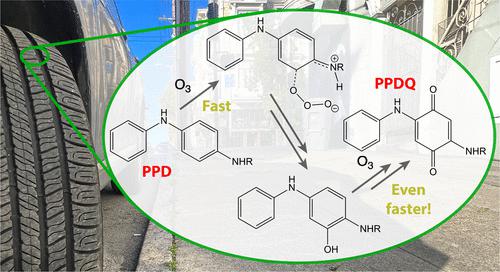当前位置:
X-MOL 学术
›
Environ. Sci. Technol.
›
论文详情
Our official English website, www.x-mol.net, welcomes your
feedback! (Note: you will need to create a separate account there.)
Computational Studies of Rubber Ozonation Explain the Effectiveness of 6PPD as an Antidegradant and the Mechanism of Its Quinone Formation
Environmental Science & Technology ( IF 10.8 ) Pub Date : 2023-03-24 , DOI: 10.1021/acs.est.2c08717 Elliot Rossomme 1, 2, 3, 4 , William M Hart-Cooper 1 , William J Orts 1 , Colleen M McMahan 1 , Martin Head-Gordon 3, 4, 5
Environmental Science & Technology ( IF 10.8 ) Pub Date : 2023-03-24 , DOI: 10.1021/acs.est.2c08717 Elliot Rossomme 1, 2, 3, 4 , William M Hart-Cooper 1 , William J Orts 1 , Colleen M McMahan 1 , Martin Head-Gordon 3, 4, 5
Affiliation

|
The discovery that the commercial rubber antidegradant 6PPD reacts with ozone (O3) to produce a highly toxic quinone (6PPDQ) spurred a significant research effort into nontoxic alternatives. This work has been hampered by lack of a detailed understanding of the mechanism of protection that 6PPD affords rubber compounds against ozone. Herein, we report high-level density functional theory studies into early steps of rubber and PPD (p-phenylenediamine) ozonation, identifying key steps that contribute to the antiozonant activity of PPDs. In this, we establish that our density functional theory approach can achieve chemical accuracy for many ozonation reactions, which are notoriously difficult to model. Using adiabatic energy decomposition analysis, we examine and dispel the notion that one-electron charge transfer initiates ozonation in these systems, as is sometimes argued. Instead, we find direct interaction between O3 and the PPD aromatic ring is kinetically accessible and that this motif is more significant than interactions with PPD nitrogens. The former pathway results in a hydroxylated PPD intermediate, which reacts further with O3 to afford 6PPD hydroquinone and, ultimately, 6PPDQ. This mechanism directly links the toxicity of 6PPDQ to the antiozonant function of 6PPD. These results have significant implications for development of alternative antiozonants, which are discussed.
中文翻译:

橡胶臭氧化的计算研究解释了 6PPD 作为抗降解剂的有效性及其醌形成的机制
商业橡胶抗降解剂 6PPD 与臭氧 (O 3 ) 反应生成剧毒醌 (6PPDQ) 的发现激发了人们对无毒替代品的重大研究工作。由于对 6PPD 为橡胶化合物提供抗臭氧保护的机制缺乏详细了解,这项工作受到了阻碍。在此,我们报告了对橡胶和 PPD(对苯二胺)臭氧化早期步骤的高水平密度泛函理论研究,确定了有助于 PPD 抗臭氧活性的关键步骤。在此,我们确定我们的密度泛函理论方法可以实现许多众所周知难以建模的臭氧化反应的化学准确性。使用绝热能量分解分析,我们检查并消除了单电子电荷转移在这些系统中引发臭氧化的观点,正如有时所争论的那样。相反,我们发现 O 3和 PPD 芳环之间的直接相互作用在动力学上是可实现的,并且该基序比与 PPD 氮的相互作用更重要。前一种途径产生羟基化的PPD中间体,其进一步与O 3反应,得到6PPD氢醌,并最终得到6PPDQ。该机制将 6PPDQ 的毒性与 6PPD 的抗臭氧功能直接联系起来。这些结果对替代抗臭氧剂的开发具有重要意义,对此进行了讨论。
更新日期:2023-03-24
中文翻译:

橡胶臭氧化的计算研究解释了 6PPD 作为抗降解剂的有效性及其醌形成的机制
商业橡胶抗降解剂 6PPD 与臭氧 (O 3 ) 反应生成剧毒醌 (6PPDQ) 的发现激发了人们对无毒替代品的重大研究工作。由于对 6PPD 为橡胶化合物提供抗臭氧保护的机制缺乏详细了解,这项工作受到了阻碍。在此,我们报告了对橡胶和 PPD(对苯二胺)臭氧化早期步骤的高水平密度泛函理论研究,确定了有助于 PPD 抗臭氧活性的关键步骤。在此,我们确定我们的密度泛函理论方法可以实现许多众所周知难以建模的臭氧化反应的化学准确性。使用绝热能量分解分析,我们检查并消除了单电子电荷转移在这些系统中引发臭氧化的观点,正如有时所争论的那样。相反,我们发现 O 3和 PPD 芳环之间的直接相互作用在动力学上是可实现的,并且该基序比与 PPD 氮的相互作用更重要。前一种途径产生羟基化的PPD中间体,其进一步与O 3反应,得到6PPD氢醌,并最终得到6PPDQ。该机制将 6PPDQ 的毒性与 6PPD 的抗臭氧功能直接联系起来。这些结果对替代抗臭氧剂的开发具有重要意义,对此进行了讨论。









































 京公网安备 11010802027423号
京公网安备 11010802027423号